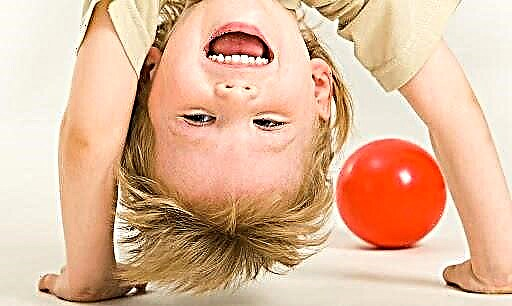
Seeing your child developed and healthy is the dream of all parents. Some of them resort to traditional massage and gymnastics at an early age to achieve their goals. Others opt for dynamic gymnastics, which, at first glance, looks like a uniform mockery of a baby - it is twisted, tossed, lifted by the arms and legs, like a rag doll. Is dynamic gymnastics so terrible and dangerous, how to carry it out at home, we will tell in this article.
Features:
Dynamic gymnastics is completely different from the usual exercises for newborns and babies. The method was invented and "put into the masses" by physiologists, early development specialists Mikhail Trunov and Leonid Kitaev. Therefore, it is often called simply "gymnastics according to Trunov-Kitaev."

The main difference lies in the fact that in classical gymnastics, exercises are carried out to a child who is in a static or light mobile state. In dynamic gymnastics, muscles are affected by more intense movement. As a result, not only the baby's muscles are trained, but also his vestibular apparatus.
The Trunov and Kitaev complex includes hardening, massage, exercises in the air and exercises on a gymnastic ball. Despite the wide distribution and popularity of these authors, their method has a considerable number of opponents, including most of modern pediatricians, including the famous doctor Komarovsky.

Opponents argue that the home use of dynamic gymnastics is a big risk to the life and health of the baby. During acrobatic stunts, the baby can get serious injuries, because even very loving parents are not professional massage therapists and exercise therapy specialists, they do not have a detailed and detailed understanding of the anatomical location of individual muscles and ligaments in the human body.
Proponents of dynamic classes assure that learning the method of labor does not constitute, but the benefits, according to them, are obvious:
- the orientation of the baby in space improves;
- increased muscle tone characteristic of all infants decreases;
- the vestibular apparatus develops and the nervous system improves;
- the child learns to trust the adult by relying on his strong hands.

Supporters and fans of dynamic exercises for babies argue that this technique allows you to compensate for a child who was born through a caesarean section, which is necessary for the harmonious development of a lack of birth experience. Kitaev and Trunov also assure parents that children who grow up on such exercises in the future are less likely to be injured by accident - breaking an arm or a leg when falling with a trained vestibular apparatus and the ability to group will be much more difficult.
What should be considered?
When deciding to start the practice of the Trunov and Kitaev system, parents should weigh the pros and cons well. Many pediatricians and child psychologists argue that you cannot ignore the possible dangers. Even if parents are in favor of dynamic gymnastics with both hands, they should know everything against in order to minimize the risks.

First of all, such gymnastics is an undeniable stress for a newborn. Not just stress, but intense stress. Nowhere in nature is it customary to shake, toss and twist cubs in the air. See how carefully a cat carries kittens, how carefully other animals do it. From the point of view of natural laws, human babies also have no prerequisites from birth to begin to fly and turn over in the air. Therefore, stress is inevitable.
It can be minimized only with the right approach - knowing when to start exercises such as increasing the load. It is better to introduce dynamic exercises gradually so that the baby has a smoother transition to an atypical body position.

At the heart of many exercises of the Kitaev and Trunov system is the use of innate reflexes of the baby. But such reflexes should disappear by the age of 3-4 months, this is quite natural. If you overdo it with dynamic gymnastics, a slow extinction of infant reflexes will occur, which will slow down the development of the child.
Traumatologists warn that it is difficult for parents to measure their strength, and therefore, after the first experiments in dynamic gymnastics without the participation of a specialist, children often end up in the hospital with sprains, fractures and other injuries. And psychologists warn that a baby may develop an incorrect perception of height, which in the future can make him a brilliant parachutist or climber, but can also cause fatal injuries due to the lack of a natural feeling of fear necessary for survival.


General rules
If, despite all the warnings, parents are determined to engage in dynamic gymnastics with their baby, it is imperative to enroll in a special group led by so-called baby coaches, exercise therapy specialists, in order to see how professionals do it, to learn techniques. We are talking about the health of your baby, here bargaining, as they say, is inappropriate.
Experts recommend starting this type of exercise with your baby no earlier than 1.5 months.
It is important that the child has no contraindications. We will talk about them below. Therefore, good and correct coaches always ask the parents for a certificate from the pediatrician that the doctor does not mind training. You also need to prepare for the fact that doctors usually refuse to give such a certificate - no one wants to take responsibility for the baby's life if the parents decide to test certain methods on him.

The Internet and video lessons, which can be very useful in mastering the techniques of classical massage and gymnastics for infants, are not assistants in matters of dynamic gymnastics. You cannot study remotely.
It is recommended to switch directly to dynamic exercises after 10-15 minutes of massage and elements of static gymnastics, so that the muscles and ligaments of the child are warmed up.
After eating, you should wait about an hour so that the baby does not burp. The place of training should be thought out to the smallest detail and completely safe, even if a fall occurs (and this can happen!).

Contraindications
Dynamic exercises are categorically contraindicated in children with the following problems:
- birth trauma;
- dysplasia of the hip joint, physiological immaturity of the joints;
- underweight (low birth weight);
- the presence of an inguinal or umbilical hernia;
- congenital heart defects;
- various neurological disorders, including ischemia.
Please note that the authors of the methodology themselves emphasize - it makes sense to conduct classes only at an early age.
If a baby developed up to 6 months and lived like everyone else, he was given a regular massage and regular exercises, it is useless and very dangerous to switch to a dynamic program. There will be no benefit from it for such a large child who has not previously done this.
A set of exercises
Usually, swinging, coups are introduced into the complex of neurodynamic gymnastics for babies at the initial stage. An adult lifts the baby only by the arms, standing at full height. Let it hang in the air. Then he lifts upside down by the legs.


The "Upper pendulum" and "Lower pendulum" are performed in the same positions. An adult stands and swings the baby, like a pendulum, first in the upside-down position, then by the legs upside down.
For more advanced stages of training, toss, toss with overturns are provided. But the basis of the technique is still made up of traditional hanging and interceptions. The most common exercise is the "Sunshine" exercise, in which the parent holds the child by the right arm and leg in weight, and then moves the limbs in a circle - grabs the left leg, left arm, and goes back to the right side. It turns out that the kid makes a "wheel" in the air.

A safer and easier to learn block of exercises on fitball, which, by the way, also refers to dynamic gymnastics. It is he who is more common, since swinging on a ball on his stomach or back does not frighten parents as much as the risky elements of the first part of the Trunov and Kitaev method.
Reviews
Many parents discussing on the Internet the possibility of doing dynamic gymnastics with their babies emphasize that reputable osteopaths, psychologists and surgeons strongly object to such classes not only because of the traumatic danger, but also because of the initially dubious benefits for the child's development. The vestibular apparatus should develop gradually, and not stressfully.

Some parents refuse to do dynamic gymnastics after the first lesson with a professional - most mothers find it completely unbearable to even watch her child being twisted like a rag doll.
Some parents use exercises quite successfully, but not entirely dynamic, but only the simplest and safest of the complex, they usually complete the most ordinary home massage and the usual daily gymnastics.
A specialist in therapeutic and restorative massage will tell you about the intricacies of performing dynamic gymnastics for babies at home in the next video.



